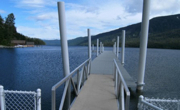Sail Transport
 A sail transport revival is afoot and afloat around the world. As the cheap, easy crude oil has mostly been extracted from the Earth and spewed into the sky and water, the desirability and economics of sail power get stronger. Sail Transport Network (STN) is an open project for almost anyone to participate in. Most of the inhabited world is coastal or on rivers. STN was put forward originally by Culture Change in 1999. We sail-transport activists envision linking coastal communities, islands, and river communities together sustainably -- |
|||
 I was discussing with a salty old colleague the possibilities of Sail Transport Network here in Portland, Oregon. It's not the perfect environment for all-wind power, but there are ways of greatly reducing petroleum for trade and transport over land and water now, before petrocollapse. One idea that relates to sail power and community-building is to help the homeless population while enhancing the whole public good. |
|||
 Carson Tak has made history as the first known modern-era sail-powered passenger service captain/entrepreneur. In his home waters of British Columbia's Georgia Strait in the Salish Sea, Carson provides travelers an alternative to the subsidized ferry that some call The Noise Boat. Besides noiselessy harnessing the wind as much as possible, his sloop Windswept beats the ferry service in some cases by offering direct voyages, so that a passenger does not have to take three ferries to make a destination. |
|||
Margot McDowell is a sail maker and seamstress in Anacortes, Washington. She has a counterpart here and there in the region, such as a woman in Port Townsend and a woman in Bellingham. Considering the number of sailboats and ongoing demand for more sails and sail repair, these sail makers barely comprise a local industry. This is because the great majority of sails are made in Taiwan -- made out of Dacron, a petroleum product. |
|||
Join us! To help the Sail Transport Network to make more strides, along the lines of this newsletter, please support our work by donating at culturechange.org/donate.html.  Several bits of good news: • B9 Shipping, part of B9 Energy that is the biggest maker of wind power units for UK's renewable energy sector, has a plan to build sail transport vessels of a major capacity. They are linking to our STN website |
|||
My lovely little sailboat just completed a most unusual catastrophe trifecta: she and I have now ridden out an earthquake in San Francisco, a multitude of hurricanes in Key West and a nasty flood in Panama. During the hurricanes my land-dweller friends ridiculed me exuberantly for staying aboard. But then enormous trees fell on their apartments. And when a devastating tidal surge destroyed their ground floor belongings, while my sloop just floated above it, they gained a reinvigorated appreciation for my “stubborn stupidity.” |
|||
 [The first two parts of this series drew a surprising amount of vitriol from people who vehemently deny the merits of the case for adapting to rapid climate change and rising sea levels — greater even than the piece ridiculing the Teabaggers. The torrent of comment spam got so bad that I had to shut down comment submission altogether. It was probably fed to some extent by the various interests which were fighting to make the Copenhagen Conference a fiasco. |
|||
 Jan Lundberg moved to Portland a year ago because it seemed like the best place to pursue his intersecting passions for food security, peak oil, bicycles, and sailing. These passions will be coming to fruition later this month when the oil analyst’s brainchild, the Sail Transport Network, will launch into its first major, ongoing local venture. Lundberg is finalizing plans to deliver malted grain from Vancouver, Washington to a brewery further down the Columbia River by a combination of cargo bike and sailboat. |
|||
 Are you still talking about Cyclone Nargis? Have you ever heard of Cyclone Nargis? Here’s a reminder: on 1 May 2008 a weakening low-pressure system suddenly picked up energy as it approached Burma from the Bay of Bengal. By the second day of this rapid strengthening, Cyclone Nargis was blowing in excess of 135 MPH and made landfall on the low-lying southern coast of Burma armed with vast reserves of cyclonic energy, a storm surge beneath, and constant heavy rain from above. |
|||
This article is the first part of a three-part series, which considers the effect of global warming on ocean level rise, and examines life with constantly advancing seas from two perspectives: that of the landlubber and that of the seafarer. Part I: The Global Mistake |
|||

